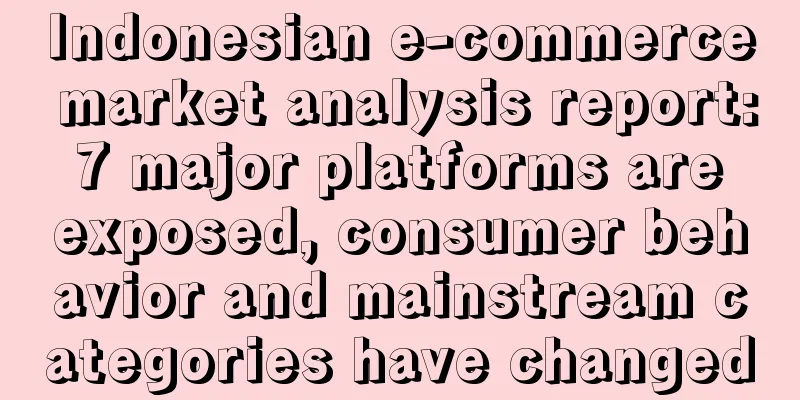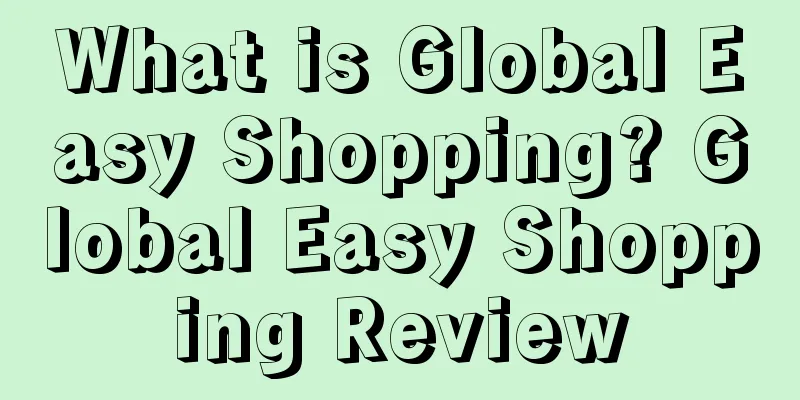Indonesian e-commerce market analysis report: 7 major platforms are exposed, consumer behavior and mainstream categories have changed

|
As the largest e-commerce market in Southeast Asia, Indonesia's e-commerce market has been hot in recent years. According to a recent study by Morgan Stanley, a US multinational investment bank, e-commerce sales in Indonesia accounted for 8% of total retail sales in 2018 and are expected to rise to 18% by 2023. The main reason for this growth is the change in shopping behavior of tech-savvy consumers, who are more willing to increase their consumption expenditures for convenience. What other important information should sellers know about the Indonesian e-commerce market? Read on. Morgan Stanley estimates that Indonesia's e-commerce market was worth $13 billion in 2018, growing at 50% per year over the past two years. This suggests that Indonesia's e-commerce market is likely to follow a similar growth trajectory as China, growing at least 32% per year over the next five years and reaching a market size of $52 billion by 2023. “This is significantly higher than our previous estimate of $7.3 billion and 4.4% sales share, driven in part by improvements in mobile data availability and a rapidly growing internet user base in Indonesia, which now lags China by only five years in terms of internet penetration,” Morgan Stanley wrote in a note. According to another study released by global technology giant Google and Singapore investment company Temasek in December last year, the Indonesian e-commerce market was worth US$12.2 billion in 2018 and will reach US$53 billion in 2025. It can be seen that this data is not much different from Morgan Stanley's estimate. The Morgan Stanley study, which surveyed 1,582 respondents from eight Indonesian cities, showed that the growth trend of Indonesia's e-commerce market is still in its early stages, with many respondents saying they only started shopping online last year. In a report released on February 5, Morgan Stanley wrote: "An interesting finding in our survey is that as many as 65% of respondents said they started shopping online in the past year, and most believe that online shopping will gradually become their main shopping method. Indonesia has 195 million smartphone users, of which only about 30 million are online shoppers. Obviously, the growth potential of the market's user base is still huge." Morgan Stanley said that in addition to the increase in smartphone penetration, the low cost of data and the increasing number of people opening bank accounts are also key factors driving the continued growth of Indonesia's e-commerce market. It is reported that the cost of each GB of data in the country is about 50 cents, while it is $2.1 in China. Currently, about 49% of adults in Indonesia have opened bank accounts, compared with only 20% in 2011. Looking at the Indonesian e-commerce market, clothing and footwear products have become the main categories driving sales growth. 93% of respondents said they had purchased such goods online in the past 12 months. Morgan Stanley said that half of them buy clothes at least once a month. In contrast, only 16% and 25% of respondents said they bought consumer electronics and mobile devices respectively, which were the most common shopping categories in the early days of the country's e-commerce market. Morgan Stanley's research points out that changes in consumer shopping behavior may affect their interaction with traditional physical stores. Three-quarters of consumers said they would check promotional information or product prices online before purchasing any products offline. Seven out of ten consumers said they would continue to shop online even if they had to pay for shipping. Morgan Stanley said this reflects that consumers are "willing to pay for convenience." In addition, the investment bank also mentioned: "Providing fast delivery is a major reason for sellers to attract consumers." The growth trend of Indonesia’s e-commerce market has brought challenges to traditional retailers to maintain profitability, and also provided a strong platform for young brands to challenge established manufacturers. “Our analysis reiterates our concerns about apparel-centric retailers like Matahari Department Store. According to our survey, the average online transaction size for apparel is already roughly the same as Matahari’s sales,” Morgan Stanley said. “The challenge for large beauty and personal care companies like Unilever is that the combination of e-commerce and digital media is making it easier for smaller companies to build brands and sell nationwide at a lower cost than before.” Investment in Indonesian internet companies has grown steadily over the past two years, with 730 deals attracting at least $7.4 billion in capital. Despite such huge growth potential, there is still no clear winner in the country's e-commerce market. In Indonesia’s e-commerce market, four companies control most e-commerce sales: Lazada, Shopee, Tokopedia and Bukalapak. The first three companies each control 20% to 30% of the market share. According to Morgan Stanley estimates, Bukalapak’s share is less than 10%. According to the investment bank, Lazada, a pioneer in Southeast Asian e-commerce platforms, remains the most popular platform in Indonesia. Morgan Stanley wrote: "Lazada has a high usage rate among users of different categories and genders, with cash on delivery being one of the key drivers of consumer preference for the platform." Shopee ranked second in terms of usage and preference, and the platform is more popular among residents of smaller cities and those purchasing baby products, toys, and beauty and personal care products. “In our survey, Tokopedia has low preference and usage among consumers outside of Jakarta. The platform’s usage rate in second-tier cities such as Surabaya, Medan and Bandung is only 38%, while in Jakarta it is 62%,” Morgan Stanley noted. A surprising finding from the survey was that Tokopedia and Bukalapak both had consumer approval ratings of over 80%, but less than 50% of consumers had shopped on either platform in the past 12 months. Morgan Stanley said: "In terms of the Southeast Asian e-commerce market, we continue to believe that the strength of the region's local e-commerce platforms is underestimated. Our survey not only confirms the popularity of Shopee, but also shows that consumers are willing to pay for delivery, which undoubtedly consolidates the path for these platforms to achieve profitability." In 2018, Indonesia’s e-commerce market set a record for online transactions in Southeast Asia with sales of US$2.7 billion. During Harbolnas, Indonesia’s National Online Shopping Day on December 12, 2018, the country’s sales reached 6.8 trillion rupiah, an increase of 2.1 trillion rupiah from 2017. The various online payment cashback services provided by Indonesian e-commerce companies have also increased consumers' enthusiasm for using e-wallets, with the country's e-wallet usage rate rising from 11% in 2017 to 15% in 2018. With this growth, the region's three major e-commerce companies, Lazada, Shopee and Tokopedia, have successfully expanded their market by as much as 7 times since 2015. According to the TOP 10 Indonesian e-commerce platform data for Q4 2018 provided by Kuala Lumpur e-commerce aggregation platform iPrice, the following are some of the highlights of these platforms in that quarter: 1. Tokopedia is still the most visited platform Tokopedia continued to attract the most website visitors in Q4 2018, with 168 million visits, up nearly 10% from the previous quarter. The reasons for its popularity include its partnership with mobile payment platform OVO, which allows users to use OVOcash and OVOpoints for transactions. In addition, Tokopedia received a $1.1 billion investment from SoftBank at the end of 2018. Following Tokopedia are Bukalapak (116 million), Shopee (29 million), Lazada (22 million), and Blibli (12 million), an e-commerce company owned by Indonesian tobacco company Djarum and Indonesian retail bank BCA. 2. Shopee wins in the e-commerce app rankings According to data from mobile app data analysis company App Annie, Shopee Indonesia APP ranked first in both the App Store and Google Play app stores in the fourth quarter of 2018. This is all thanks to the platform's two major strategies: promoting year-end promotions themed around Harbolnas, 11/11 and 12/12, and offering consumers limited-time deals, free shipping and up to 120% cashback, which successfully attracted Indonesian consumers to shop on the platform. Following Shopee on the App Store and Google Play rankings are Tokopedia (#2) and Lazada (#3). 3. Zalora is the leader among local fashion e-commerce platforms Zalora saw its highest ever visitor numbers in Q4 2018 since it began operations in 2012. The platform saw a 2 million increase in visits, far outpacing second-placed Sophie Paris, which saw a 100,000 increase in visits. Ranked third, fourth and fifth are Islamic fashion e-commerce companies Hijup, Berrybenka and men's fashion e-commerce company Bro.do. 4. Instagram is the most effective social media marketing platform It is reported that brands that promote products on Instagram successfully reach all fans, far exceeding Facebook, which only affects about 6% of brand fans. 5. Sociolla wins more trust Sociolla, an e-commerce company specializing in beauty, makeup, and perfume products, saw a 35% increase in website visits compared to the previous quarter. The company's strategy of collaborating with beauty influencers and bloggers to offer discount coupons has successfully attracted consumers' attention. Buyers and product users also actively comment and share their experiences after shopping on the platform. 6. iLotte becomes the biggest dark horse iLotte, which was launched in 2017, has become one of the top 10 e-commerce companies in Indonesia thanks to its free concert ticket promotions, with 3.5 million website visits in the fourth quarter of 2018. 7. Elevania is losing ground Compared to the previous quarter, Elevania's ranking dropped from 8th to 9th place, and its website visits dropped from 4 million to 3.9 million. It is understood that not offering more discounts and freight subsidies is the reason behind its decline. |
<<: The most complete sales guide on Amazon: How to sell shoes on the platform and make a profit
>>: Suwen Data went bankrupt? Employees collectively demanded their wages and the sellers panicked
Recommend
What is MarkaVIP? MarkaVIP Review
MarkaVIP is an e-commerce website with a flash sal...
Q4 US e-commerce marketing calendar! Don’t miss these hot sales points!
<span data-docs-delta="[[20,"获悉,近日,市场研究公司D...
Walmart joins forces with TikTok and other companies to help sellers attract traffic during peak season!
<span data-docs-delta="[[20,"获悉,据外媒报道,沃尔玛的...
Online Sellers Association appeals for rights protection! "Price fraud case" wins a glimmer of hope!
, Since April this year, more than 6,000 seller a...
Q3 revenue and profit both fell! Where does FedEx get the courage to raise its full-year profit forecast?
It was learned that on March 16, FedEx raised its...
Mexico's version of "Double Eleven" is coming! Amazon is the preferred platform for online shoppers!
It is learned that according to foreign media repo...
What is Red Balloon? Red Balloon Review
Red Balloon is an Australian local service booking...
What is the ACE Program? Review of the ACE Program
The ACE (Amazon Category Engine) program is a prod...
What is GTIN? GTIN Review
The Global Trade Item Number (GTIN) is a set of di...
Walmart launches the "Walmart Restored" program! Entering the second-hand refurbished market!
<span data-docs-delta="[[20,"获悉,据外媒报道,沃尔玛将...
FBA pilot new function! Ranking traffic is not affected by out-of-stock
How much impact does out-of-stock have on product...
The first big sale of the year is comparable to "Prime Day", Wish is trying to save itself
Since its listing in 2020, Wish has experienced mu...
Amazon logistics tips to avoid pitfalls!
In the past two years, cross-border e-commerce ha...
Operation Tips-Solutions for Amazon Store Closure
First of all, let me ask everyone, if your accoun...









